

Athletic Park, Luna Park, Carnival Court Park - Buffalo N.Y.
1904 - 1918
Written by Jeffrey Stanton
Buffalo residents having experienced the midway at the 1901 Pan-Pacific Exposition, longed for an amusement park in their city. The Expo’s midway attractions were moved to various other cities, many to Brooklyn’s Coney Island. In 1904 Detroit capitalists and promoters formed the corporation to erect one at an unused five-acre park on Main and Ferry Streets. The location was promising as it was in a residential section of town where six trolley lines stopped at the resort. These included the Lockport, Niagara Falls, Tonawanda, Ketinofe and Olcott Beach lines. And it was a 12 minute trolley ride from the heart of the business district. Its president was W.J. Walter; Samuel L. Robertson, a local attorney was vice-president. And Robert F. Walter was secretary and general manager.
The New York Clipper and other newspapers announced that there would be 30 forms of amusement in Athletic Park when it opened on Decoration Day (Memorial Day), 1904. These would include a mammoth figure 8 roller coaster, Old Mill, giant circle swing, Helter Skelter slide, Kattzenjammer Castle, Cave of the Winds, Mystic Top, Laughing Gallery, House of Trouble (fun house), Miniature Railroad, merry-go-round, Ferris wheel, Dragon Rouge, and Dante’s Inferno. A Porteville, NY newspaper also listed the Galveston Flood, Trip to Mars, new Parisian Novelty and a pony track that were listed in a Billboard Magazine advertisement, so it is possible that additional attractions were added. In the theater beside vaudeville there was concerts by military bands, and other musical organizations. Kilties Band with 60 musicians gave their farewell American concert before returning to Europe. A first class Vaudeville Theater gave free performances twice a day, and the acts were changed weekly.
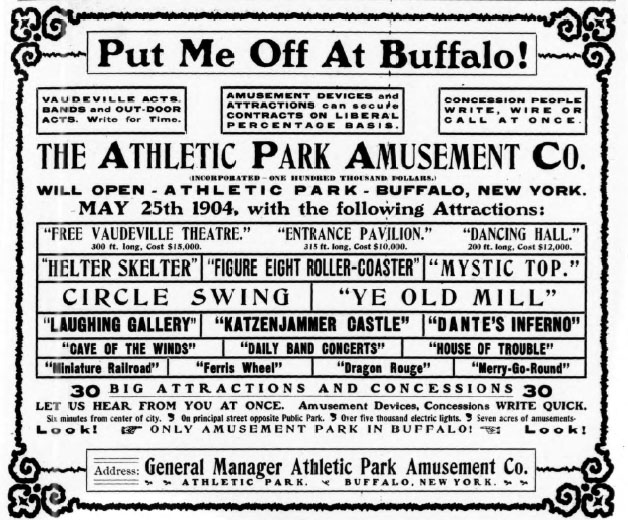
Athletic Park - 1904 Billboard Advertisement
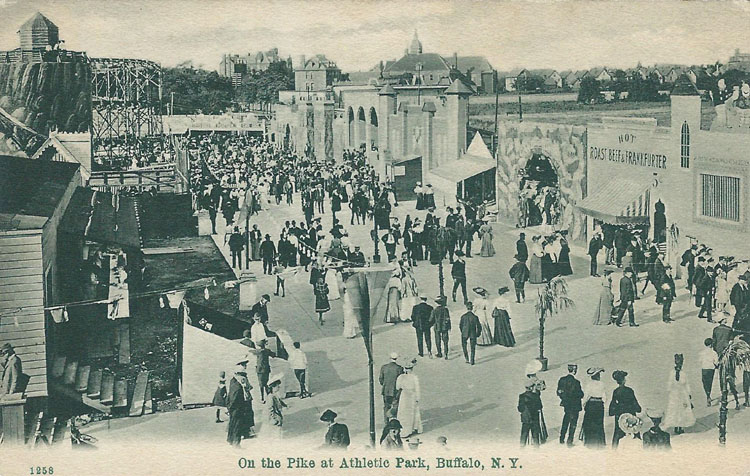
Athletic Park - Midway View
Attractions were changed and for the 1905 season, George Rollins, who was previously in Frank Bostock’s show, had his own six big-wagon animal show featuring trained monkeys, and Wallace the untamable lion. New shows included the Hereafter depicting heaven and hell.
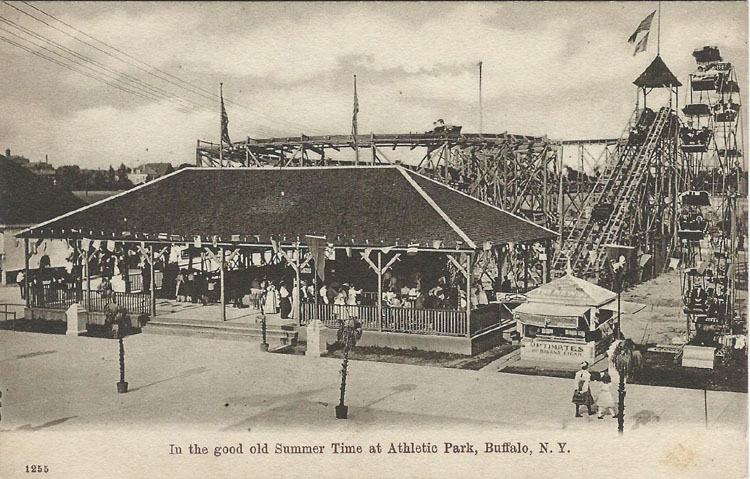
Athletic Park - Figure 8 Railroad
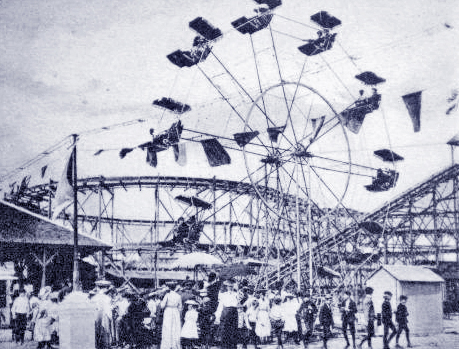
Athletic Park - Figure 8 Railway & Ferris Wheel
Manager R.H. MacBroom managed Athletic Park for its third season Its new Mystic Swing was the biggest feature on the Atlantic City boardwalk the previous season. Bump the Bumps (a slide) was placed next to the North Pole concession. The Battle of Manila was in the building that previously housed the Hereafter, and it was proposed to have the show San Francisco Destroyed in that building later that summer. A theatorium occupied the building that contained the Laughing Gallery A new $12,000 dancing pavilion was erected between the Figure 8 and theater.
In September 1906 park officials announced that they had acquired an additional 10 acres immediately north of the park and to spend $100,000 to expand. Planned was a new Shoot-the-Chutes, scenic railroad and other attractions.
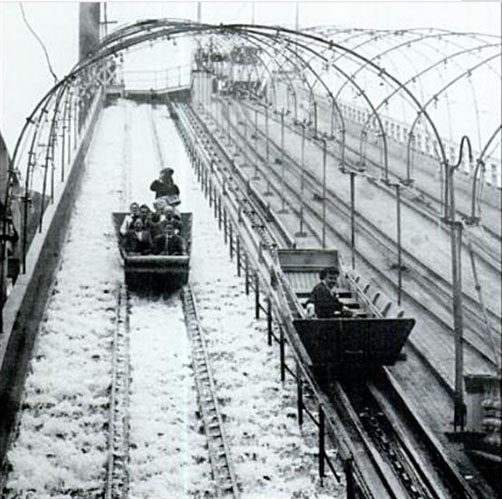
Luna Park - Buffalo - Shoot-the-Chutes
Luna Park, known for the past three years as Athletic Park opened its gates May 22, 1907.Since early spring a large force of men has been building. reconstructing, renovating the park. The park has been enlarged by two acres on the north end. The park kept its Figure 8 coaster, Old Mill, Circle Swing, Merry-go-round and Cave of the Winds. Everything else was new.
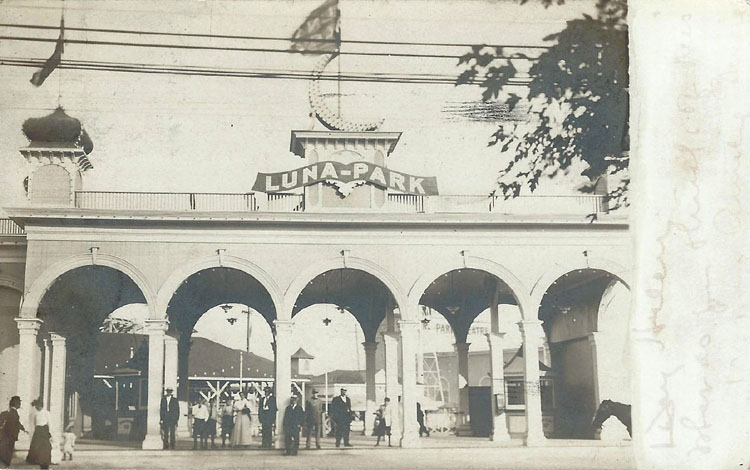
Luna Park - Entrance
The Giant Auto Dip, which took up half the park, cost $25,000. It was larger than the Figure Eight with the trip taking nearly twice as long. The ride had deep dips and three 80 foot tunnels with the top tunnel mouth resembling the mouth of a cannon. The cars were patterned after automobile touring cars and the structure was brilliantly lighted and attractively decorated.
One of Luna Park’s new attractions was the Human Laundry, a fun house that cleans a person like a soiled shirt. Features inside included a giant revolving washing tub (no water), a wringer, which gently squeezed those who passed through, and hot air blowers to dry the person’s attire. Love's Voyage was an old mill style ride. Across the Seas took visitors to foreign locales to give the visitor the sight of countries he had only read about. Fantama, one of the biggest illusions ever exhibited in Buffalo, opened in a building that was formerly the home of a diver who showed what was done under water by a boat repairer. Camp Doomsday, one of last season's most meritorious attractions, will be exhibited on the spot where Dante's Inferno and the Old Plantation were located. This building was the most elaborate in the park. A Razzle Dazzle occupied the space between the theater and Circle Swing. And the Bumps opened in the same location. A new moving pictures exhibition was shown in the Trolley Tours building. There was both roller skating and dancing in the big dance pavilion, and next to The Bumps will be the House Upside Down.
The opening week featured Rosail's Naval Reserve Band of 40 pieces. Free acts in front of the grandstand twice daily (1 PM and 9 PM) included Dankmar-Schiller troupe of European acrobats and & Wormwood's trained animals – The vaudeville bill included Hartlett and Gorman - comedy act; Jules Levy & Co. - novelty musical act; Gary Ownes - comedy sketch and Jack Irwin – monologue. In late June the park designated Tuesdays as children’s day and many attractions were free. The free outdoor act included George and Georgie - double trapeze performers and Kishiruna troupe of eight Japanese acrobats.
New attractions for the 1908 season were Ferrari Wild Animal Show and the Tickler, a ride that serpentine down a sinuous course on a ramp. Balloon ascensions were quite popular that summer. Apparently the Buffalo economy was going through hard times and attendance was just fair.
The 1909 season began on May 30th, but was badly damaged in a fire that broke out shortly before 3 AM on July 14th. After the alarm was sounded, fireman found the skating rink in flames. From this building the fire shot to the theater and from the theater the flames spread to the figure eight coaster. Then one by one the fire ate up different buildings containing various shows. The Japanese exhibit and the Cave of the Winds burned, and luckily the grandstand was partially saved. By additional fire companies summoned to fight the fire. Manager R.H. McBroom estimated the loss at $45,000 - which $22,000 was the theater, $13,000 the rink and $5,000 various concessions.
It was announced on December 25, 1909 by the new owner C.A. Johnson, who will give it his personal attention and spend $250,000 on new attractions. Out of the ashes of old Luna Park will arise a magnificent place of recreation, fun and amusement called Carnival Court. Arthur C. Williats would be the park manager He previously managed Paul Boyton;s World's Water Show in London, Paris and Antwerp, and two summer ago the amusements at Crystal Beach. They cleared off all that remained of the old park and built on all 10 acres of the park’s grounds.
The L.A. Thompson Company erected a scenic railway of over one mile in length at a cost of $75,000. A new carousel was designed and built, and mammoth skating pavilion erected, and an octagonal dancing pavilion occupied a large portion of grounds where the grandstand stood. On the site of the old Mill a Venice attraction was built where gondoliers lazily glided down and around pretty scenic canals. When it opened on Decoration Day 1910, the price of admission was 5 cents with the aim to cater to ladies and children during the afternoon sessions.
Little changed for the 1911 season, but the park had a new manager Dentry. They erected a large pavilion for feature attractions including motion pictures. For the 1912 season, the L.A. Thompson Company changed much of the scenery in their scenic railway. The park wasn’t very profitable, and in August 1913 the owner sold the park to Harry G. Johnson, E.C. Sutton and L.H. Sutton for $125,000.
Either nothing was newsworthy at Carnival Court for the 1914 season, or the park didn’t send out press releases. Billboard does mention that the park was overhauling its buildings in time for a May 22, 1915 opening. These include the airdrome, dancing pavilion, witching waterways, old Vienna, and L.A. Thompson scenic railway. New acts will be at the Court and motion pictures exhibited each night.
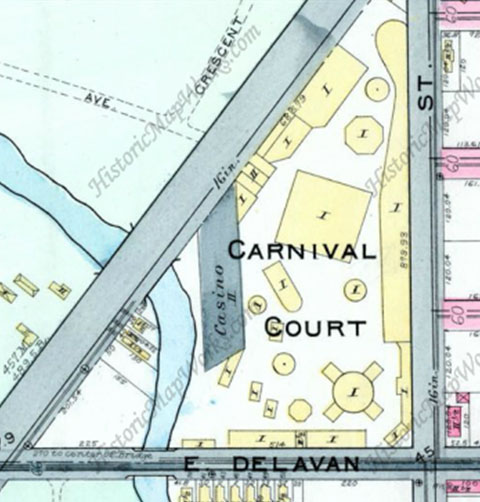
Carnival Court Park - 1915 Map
A 1917 article mentions that the midway was a continuous blaze of light from 7:30 until 1 A.M. when the park gates closed for the night. The big free acts and motion pictures held the crowds for 55 minutes during the first part of the night. The concessions resumed at 8 PM until closing. In the cabaret 18 entertainers were engaged and free dancing prevailed. Unfortunately the Casino roller rink and other attractions burned in a fire on December 15, 1917. The rink was valued at $15,000. It was built in 1910 by Carnival Court Concession Co., which opened as Palace de Dance, but the building never completely finished. Six months later Hilbert W. English leased the building and turned it into a skating rink.
Billboard announced in March 1918 that Carnival Court was building a new roller skating rink to replace the one gutted by fire in December. And that many new attractions were to open for the 1918 season. If it did actually open for the 1918 season, it was its last. It could not expand and compete with various lakeside resorts like Crystal Beach and Olcott Beach.
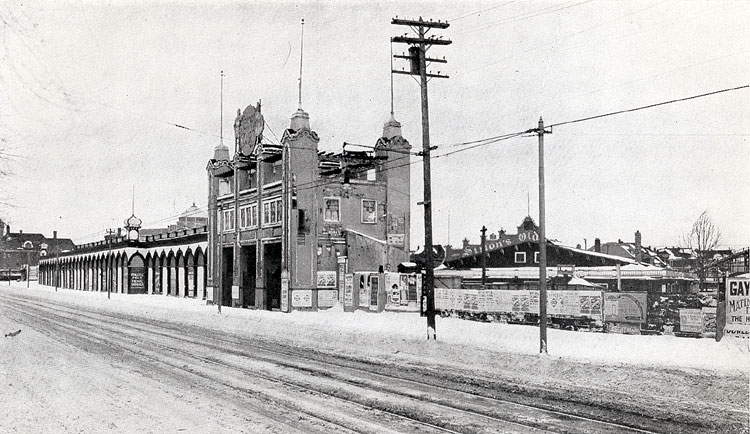
Carnival Court after park closed - 1920